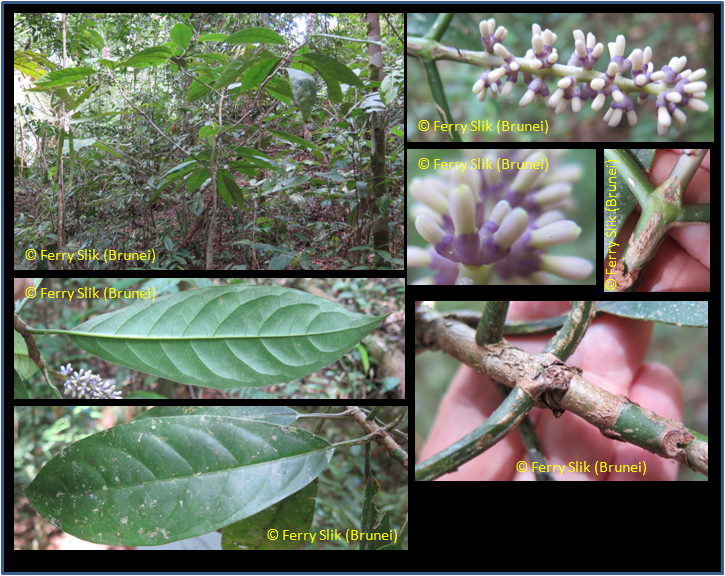Rennellia elliptica Korth., Ned. Kruidk. Arch. 2(2): 257 (1851)
Species name meaning 'elliptic' referring to the leaves.Synonyms
Ixora subcuneata (Miq.) Kuntze
Morinda sumatrana Miq.
Pavetta subcuneata Miq.
Rennellia ovalis Korth.
Rennellia speciosa var. angustifolia Ridl.
Diagnostics
Small tree or shrub, 1.5-2 m height; stem lignosus; leaves elliptic, 8-23 cm long, glabrous,
dark green or pale green coloured; petiole long; inflorescences terminal; flowers white or dark
purple coloured, very fragrant; corolla tube purple coloured; infructescence terminal; fruit
globose, green coloured.
Description
Small tree or shrub, 1.5-2 m height. Branchlets when young quadrangular and becoming
subquadrangular or quadrangular with age, bark glossy or not, pale yellow to brown coloured
when dry; internodes 3-89 mm long, 1.5-5 mm wide, 0.5-5 mm thick. Stipules triangular or ovate or
suborbicular, short, connate or almost free, apex short bifid or obtuse or acute acuminate or
rounded, subchartaceous or submembraneous, veins distinct or not, 2-5 mm long, 2-6 mm wide.
Petioles subterete or semi-terete or subquadrangular, flattened or protruded, 6-38 mm long,
0.75-2 mm wide. Lamina obovate, obovate-oblong, elliptic-oblong, lanceolata-oblong to lanceolate,
5.3-25.6 cm long, 1-8.2 cm wide, apex acuminate or short cuspidate, chartaceous when dry, drying
pale yellow or pale yellow brownish below, pale yellow or pale yellow greenish to brown or pale
yellow brownish coloured above when dry; secondary veins 7-9(-10) pairs, slightly to prominently
raised below, flat to moderately raised above; midribs flat to moderately raised above and
prominently raised below; tertiary veins flat to slightly raised below and indistinct to
slightly raised above. Bracts triangular or narrowly triangular or elliptic, apex short
bifid, acute or obtuse, glabrous, membraneous, 0.25-0.75 mm long, 0.1-1 mm wide. Inflorescence
axis subquadrangular, 5-51 mm long, 1-2 mm wide, internodes 0.75-7 mm long; peduncles subterete or
subquadrangular, (0.75-)1.5-2.5 mm long, 0.5-1.5 mm wide. Flowering heads arranged in a spike-like
to subraceme-like structure, never sessile, in 2-12 tiers along the inflorescence axis, each head
with 2-3 flowers, 1.5-3.5 mm long, 2-5 mm wide. Flowers homostylous, 2.5-6 mm long, 0.75-2.25 mm
wide; calyx tube subcampanulate or campanulate, 0.75-2 mm long, 1-2.25 mm wide; corolla tube 1 mm
long, 0.5-1 mm wide; corolla lobes 4-5, lanceolate or linear-lanceolate or oblong or elliptic,
(1.75-)3-4.25 mm long, 0.5-1.5 mm wide, apex obtuse or acute; stamens 4-5; anthers linear-
lanceolate, (1-)1.5-1.75(-2.25) mm long, 0.2-0.4 mm wide; filaments 0.25-0.75 mm long, 0.1-0.3 mm
wide; stigma lobes ovate-elliptic, 0.2-0.5(-0.75) mm long, 0.1-0.25 mm wide; style 1-1.75(-2.1) mm
long, 0.1-0.3 mm wide. Fruits subglobose or ovoid, 2-7 mm long, 2-9 mm wide, glabrous, locules 2-3.
Stalks subterete, 1.25-3.25 mm long, 1-1.5 mm wide. Seeds ovoid or globose, 3.75-6 mm long, 3.5-4.75
mm wide, 0.5-1 mm thick, 1-2 per locule. [from Biodiversitas 9: 259-263]
Ecology
Found along riverbanks or lowland forest, at altitude 40-650 m above sea level.
Uses
Decoction of the roots is taken by the locals for general good health and also claimed to be
antidiabetic.
Distribution
Peninsular Malaysia, Sumatra and Borneo.
Local names
Borneo: Kayu Penawar Apow (Dus.), Mengkudu Hutan (Ib.).
Sumatra: Jarum-Jarum Betina, Kayu Kuni, Kayu Kemik (Minangkabau).
